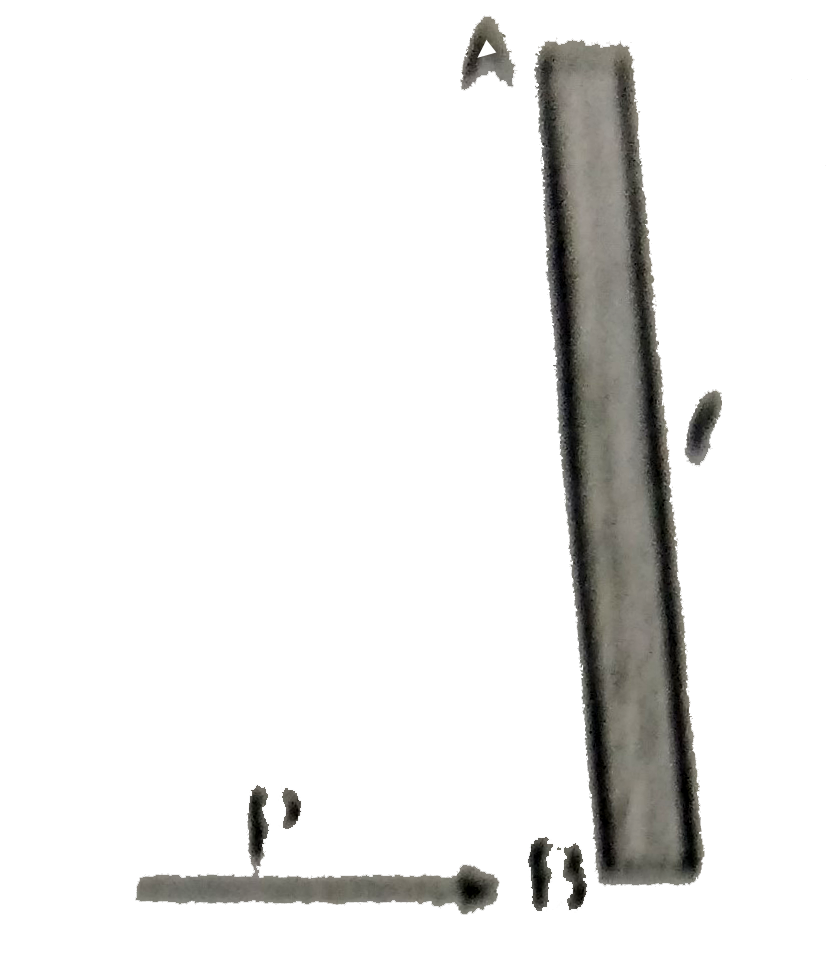A block of mass m collides with another block of mass 3m completely inelastically as shown in figure. What is the maximum value of v( in m/s) for which the block B does not move. Assume that initially spring is in natural length and blocks A and B are at rest. (K/m=100S.I.unit )

The correct Answer is:2
Velocity of (A+C),
V1=V1+3=V4
If B does not move, maximum compressionX in the spring is
12KX2=12×4m(v4)2
∴X=(4mK).v4
∴KX=μmg
⇒100.√4100.v4=1×10
⇒v=2m/s Ans. 2
Topper's Solved these Questions
- BOOK - RESONANCECHAPTER - DAILY PRACTICE PROBLEMSEXERCISE - dpp 724videos
DAILY PRACTICE PROBLEMS
- BOOK - RESONANCECHAPTER - DAILY PRACTICE PROBLEMSEXERCISE - dpp734videos
DAILY PRACTICE PROBLEMS
- BOOK - RESONANCECHAPTER - DAILY PRACTICE PROBLEMSEXERCISE - dpp 707videos
DAILY PRACTICE PROBLEMS
- BOOK - RESONANCECHAPTER - CURRENT ELECTRICITYEXERCISE - Exercise54videos
CURRENT ELECTRICITY
- BOOK - RESONANCECHAPTER - ELASTICITY AND VISCOCITYEXERCISE - Advanced Level Problems9videos
ELASTICITY AND VISCOCITY
Similar Questions
A continuous stream of particles, of mass m and velocity r, is emitted from a source at a rate of n per second. The particles travel along a straight line, collide with a body of mass M and get embedded in the body. If the mass M was originally at rest, its velocity when it has received N particles will be
07:01View SolutionA particle performs SHM of amplitude A along a straight line .When it is at a distance of √32A from mean position its kinetic energy gets increased by an amount of 12mω2A2 due to an impulsive force. Then its new amplitude becomes
04:28View SolutionA uniform rod AB of mass m and length l at rest on a smooth horizontal surface . An impulse P is applied to the end B. The time taken by the rod to turn through a right angle is :
 04:08View Solution
04:08View SolutionSpecific resistance of a wire depends on its
02:49View SolutionA wire loaded by a weight of density 7.6gcm−3 is found to measure 90cm. On immersing the weight in water, the length decreases by 0.18cm. Find the original length of wire.
06:01View SolutionA block of mass m is connect to another block of mass M by a massless spring of spring constant k. The blocks are kept on a smooth horizontal plane. Initially the blocks are at rest and the spring is unsrtretched when a constnt force F starts acting on the block of mass M to pull it. Find the maximum extension of the spring.
 02:59View Solution
02:59View SolutionA block of mass m is connected to another block of mass M by a spring (massless) of spring constant k. The block are kept on a smooth horizontal plane. Initially the blocks are at rest and the spring is unstretched. Then a constant force F starts acting on the block of mass M to pull it. Find the force of the block of mass M.
View SolutionTwo identical blocks A and B , each of mass m resting on smooth floor are connected by a light spring of natural length L and spring constant k , with the spring at its natural length. A third identical block C (mass m ) moving with a speed v along the line joining A and B collides with A . The maximum compression in the spring is
07:27View SolutionA block of mass 'm' is connected to another block of mass 'M' by a spring (massless) of spring constant 'k' The blocks are kept on a smooth horizontal plane. Initially the blocks are at rest and the spring is unstretched Then a constant force 'F' starts acting on the block of mass 'M' to pull it. Find the force on the block of mass 'm' :
02:33View SolutionA block of mass m is placed on a smooth block of mass M = m with the help of a spring as shown in the figure. A velocity v_(0) is given to upper block when spring is in natural length. Find maximum compression in the spring.
02:33View SolutionA block of mass 'm' is connected to another block of mass 'M' by a spring (massless) of spring constant 'k'. The blocks are kept on a smooth horizontal plane. Initially the blocks are at rest and the spring is unstretched. Then a constant force 'F' starts acting on the block of mass 'M' to pull it. Find the force on the block of mass 'm'.
View SolutionA block of mass m is connected to another block of mass M by a spring (massless) of spring constant k. The blocks are kept on a smooth horizontal plane. Initially the blocks are at rest and the spring is unstretched. Then a constant force F starts acting on the block of mass M to pull it. Find the force on the block of mass m.
View SolutionA block of mass m is connected to another block of mass M by a spring (massless) of spring constant k. The blocks are kept on a smooth horizontal plane. Initially the blocks are at rest and the spring is unstretched. Then a constant force F starts acting on the block of mass M to pull it. Find the force on the block of mass m
04:08View SolutionA block of mass m moving with speed v collides with another block of mass 2m at rest. The lighter block comes to rest after the collision. The coefficient of restitution is
View SolutionA block of mass m moving with speed v collides with another block of mass 2m at rest. The lighter block comes to rest after the collision. The coefficient of restitution is
03:08View Solution

